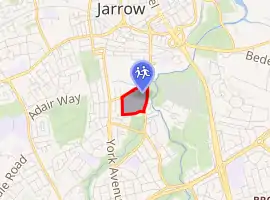Jarrow School
Jarrow School is a coeducational secondary school located in Jarrow, Tyne and Wear, England admitting pupils aged 11 to 16.
| Jarrow School | |
|---|---|
| Address | |

| |
Field Terrace , , NE32 5PR England | |
| Information | |
| Type | Foundation school |
| Local authority | South Tyneside |
| Department for Education URN | 133725 Tables |
| Ofsted | Reports |
| Head teacher | Miss J Gillies |
| Gender | Coeducational |
| Age | 11 to 16 |
| Enrolment | 619 |
| Website | www |
History
It was opened on 6 January 2003 following the merger of Springfield Comprehensive and Hedworthfield Comprehensive, and is based at the old Springfield site. Its full title is Jarrow School, Engineering Excellence In Education, the result of a competition to choose an inspirational name for the new school. In 2007 the school became a specialist Engineering College. [1]
The former Jarrow Grammar School opened in 1911. In June 2010, this building was demolished.[2]
In October 2013 the school's headteacher Sir Kenneth Gibson became the first person to be knighted by Prince William, Duke of Cambridge.[3]
Springfield
Springfield was Jarrow's grammar school and was formerly known as Jarrow Grammar School.It became a comprehensive school in 1975 to cater for all prospective pupils' academic abilities, in common with the other schools in the area including Hedworthfield.
Hedworthfield

Hedworthfield was designated as a complementary secondary modern school to Springfield's provision as the local grammar school. It was a newer development built in the 1960s at Fellgate on the outskirts of Jarrow. Extensive building work was completed in the late 1970s providing the school with better facilities for arts and crafts, a music and drama studio, a community centre and a sports complex containing badminton and squash courts, a gym and other facilities.
Alongside Springfield, it was converted to a comprehensive school in 1978. However, following its redesignation, some parents still insisted on sending their children to Springfield, even though they were no longer in its catchment area; they cited concerns that an ex-secondary modern school might not measure up to the same academic standards as the former grammar school. Additionally, Hedworthfield had no provision for teaching 6th form pupils, meaning that those choosing to study subjects at A-level had to relocate once they had completed their O-levels or GCSEs. Generally, 6th form students opted to transfer to Springfield to continue their education.
Merger
Following the dwindling number of pupils for the new intake year-on-year, it became apparent that continuing to fund the running of both schools in parallel was no longer viable, so a merger into a single school was proposed. After some debate as to whether it should be on one of the existing sites, or an entirely new site funded by a Private Finance Initiative, the decision was taken to locate the merged school at the Springfield campus.
Hedworthfield's OFSTED results were surpassing those of the historically more academic Springfield for some time prior to the merger. Students at both schools protested, and more than 100 pupils at Jarrow School were involved in a "near riot" during the summer of 2003, during which police made three arrests.[4]
New building
The old Jarrow School building has been replaced by a new school on the same site, funded by Building Schools for the Future. The old school was a built during the reign of Queen Victoria (Victorian Era) and by the millennium was in serious need of either refurbishment or a re-build. It was then decided that the old school was to be demolished and replaced with a modern new school which was funded by Building Schools for the Future scheme and designed by Inspired Spaces. The new building has an outstanding learning environment with light, airy rooms and thriving with high class facilities.
Academic performance
GCSE results were below the national average. The school was not known to concentrate on the more crucial subjects like Maths and English. Results for these subjects were poor, around 40%. However, this year's (2012) results show a significant increase in achievement with 97% of mainstream students gained 5A*-Cs and 57% of students who accessed the mainstream curriculum gained 5A*-Cs including English and maths, a significant increase of over 7% on last year's figure. There is only one school in South Tyneside LEA has a sixth form, and A-levels are available at the South Tyneside College.
Notable former pupils
Jarrow Grammar School
- David Blakey CBE, Chief Constable from 1991 to 1999 of West Mercia Police
- Steve Cram MBE, athlete
- Jack Cunningham, Baron Cunningham of Felling, politician
- Jarra Elvis, world famous musician
- Robin Donkin, historian
- Peter Duguid, actor
- Rear-Adm Sir John Fleming DSC, Director of the Naval Education Service from 1956 to 1960
- Prof Ronald Hedley, Director from 1970 to 1980 of Trent Polytechnic
- Hare Kutzz, managing director of Good Hair Day 2001-2003
- Doug McAvoy, General Secretary from 1989 to 2004 of the National Union of Teachers (NUT)
- John Miles (John Errington), musician
- Fergus Montgomery, Conservative MP from 1959 to 1964 for Newcastle upon Tyne East, from 1967 to 1974 for Brierley Hill, and from 1974 to 1997 for Altrincham and Sale West
- James Porteous, Chairman and Chief Executive from 1990 to 1992 of the Yorkshire Electricity Group plc
- Alan Price, musician
- Maj-Gen Eric Younson OBE, President from 1972 to 1973 of the Ordnance Board
Springfield Comprehensive School
- Alan Donnelly, Labour MEP from 1989 to 1999 for Tyne and Wear
- Stephen Hepburn, Labour MP since 1997 for Jarrow
References
- http://www.jarrowschool.com/
- Jarrow School
- https://www.theguardian.com/uk-news/2013/oct/17/prince-william-debut-queen-knighthoods
- "Head of troubled school quits". BBC News Online. BBC. 24 December 2003. Retrieved 5 October 2007.